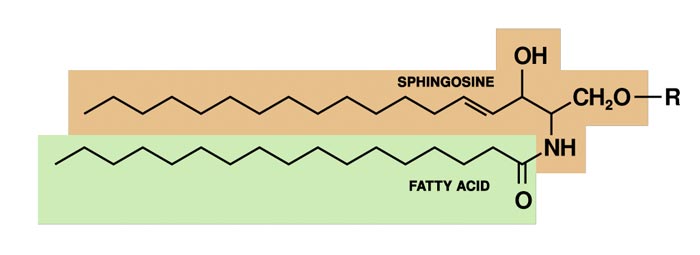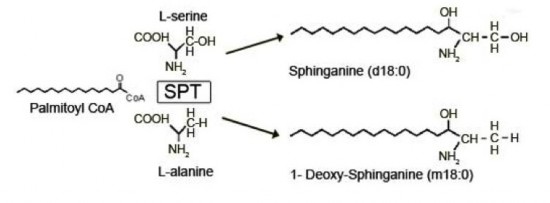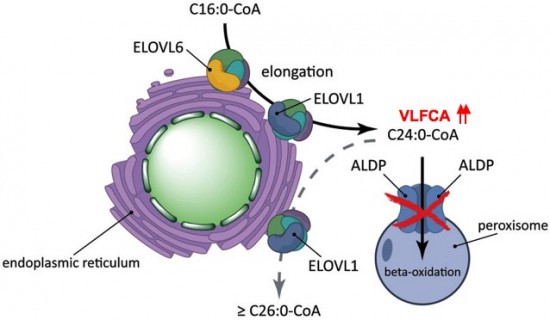Introduction to Lipids
A. What is a lipid and why are they important?
– Lipids are naturally occurring, hydrophobic molecules that include fats, waxes, sterols, phospholipids and others.
– Lipids make up 70% of the dry weight of the nervous system. They are crucial to healthy functioning of nerve cells.
– Lipids are important to basic biological functions such as energy storage, membrane structure, myelin, and signaling molecules.
B. What lipids do we study (associated disease in parentheses)?
1. Sphingolipids (HSAN1)
2. Very Long Chain Fatty Acids (X-ALD)
3. Gangliosides (Tay Sachs)
1. Sphingolipids – accumulation of abnormal sphingolipids is observed in HSAN1 (see here for more on our HSAN1 research) patients due to mutations to in SPTLC1, a gene responsible for synthesis.
a. What is a sphingolipid?
– A class of lipids that are highly enriched in neural tissue.
– Sphingolipids are important in cell signaling, lipid rafts, myelin and cell membranes.
– Above is the typical structure of a sphingolipid. Changing the R group will result in different sphingolipids.
b. Normal Metabolism:
– Serine Palmitoyltransferase (SPT), the enzyme mutated in HSAN1 patients, rings together the amino acid L-serine and Palmitoyl CoA to form the first metabolite in the sphingolipid pathway. Other enzymes then use that first metabolite to make other sphingolipids with distinct structures and biological functions.
c. Atypical lipids – Deoxysphingoid Lipids (dSLs):
– In HSAN1, a mutation to one of the subunits of SPT causes the enzyme to lose its affinity for L-serine and now binds L-alanine with Palmitoyl- CoA
– When L-alanine is bound, the atypical Deoxy-Sphinganine is formed instead of Sphinganine. This reaction is illustrated below:
Figure: The top pathway (L-serine) is the normal reaction.
The bottom pathway (L-alanine) is the atypical reaction found in HSAN1.
2. Very Long Chain Fatty Acids (VLCFA) – accumulate in X-ALD (see here for more on our X-ALD research) due to an abnormal ALD protein, coded by the ABCD1 gene.
a. What is a Fatty Acid?
– a carboxylic acid (COOH) with a long unbranched carbon tail (chain), which is either saturated or unsaturated.
b. What is a Very Long Chain Fatty Acid (VLCFA)?
– a fatty acid with a tail of 20 carbons or more.
c. What goes wrong in X-ALD?
i. VLCFA are ingested via diet or created in the body by ELOVL1.
ii. VLCFA are degraded in the peroxisome.
iii. ALD protein is required for moving the VLCFA across the peroxisomal membrane for degradation.
iv. ALD protein (ALDP) is abnormal due to ABCD1 mutation.
v. VLCFA are not efficiently transported into peroxisome, thus cannot be degraded and VLCFA build up as a result.
From Kemp & Wanders , 2010
d. What do these VLCFAs do when they build up?
– This is the focus of the research of our lab and others around the world.
– We are now working to understand whether VLCFA are merely biomarkers correlated with disease onset or are themselves neurotoxic.
3. Gangliosides – are a specific type of complex sphingolipid which are elevated in Tay Sachs (see here for more on our Tay Sachs research) due to a mutation of a lysosomal enzyme.
This section is still under construction. Check back soon!




